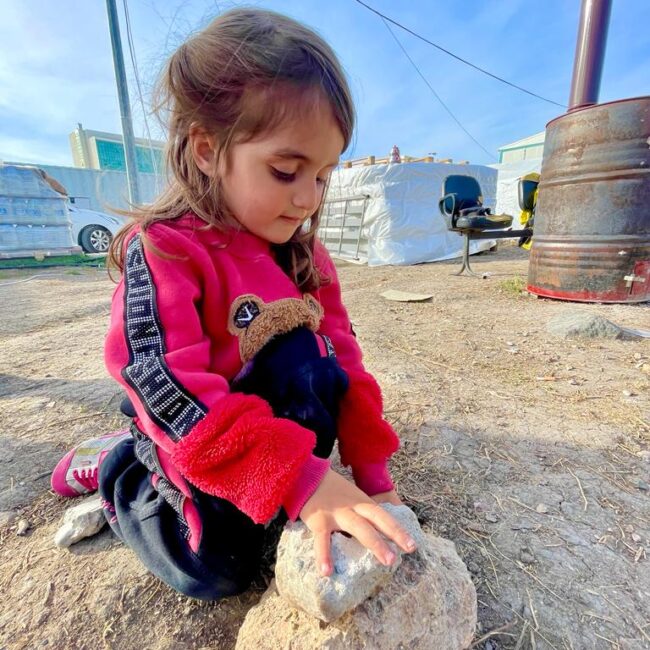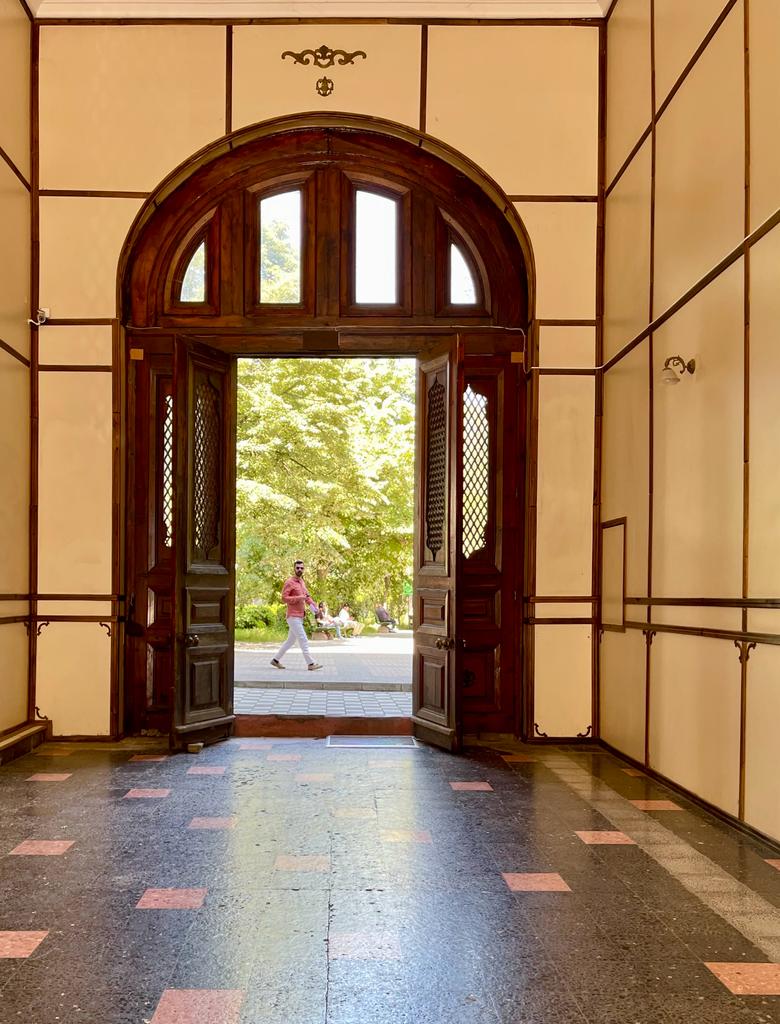
United in New Reality
Imagine being startled awake by a horrifying sound – like an explosion – followed by zipping jolts and literally falling into a new reality that you had no idea could exist before, in which all the words you learned don’t mean what they used to mean.
After the earthquakes in Türkiye and Syria last month, houses – homes – do not mean safe places to many of us anymore. On the contrary, they are so treacherous that you cannot even step in. Stairs are not to climb to the next floor. Doors are not to welcome you into a place; they are like street accessories without serving a purpose.

Curtains are not to cover windows; they are meaningless without windows or walls; they flutter in the breeze to reveal the debris between flattened floors like ghosts in horror movies; they are still attached to a sort of structure when everything else is detached or dissolved.
 Kitchens are not to cook anymore; they sit on the ground fully exposed to passersby if any.
Kitchens are not to cook anymore; they sit on the ground fully exposed to passersby if any.
Food is not cooked at home; there is no home. Food is cooked by disaster relief organizations from places you might have never heard of before or know how to even pronounce. Schools are not for education; hospitals are not for treatment; they are abandoned.
 Tents are not for camps; you live in them now, if you are lucky enough to get all the required approvals and if there are any left. Yards, parks or empty spaces are not for recreation anymore, they are for tents or containers.
Tents are not for camps; you live in them now, if you are lucky enough to get all the required approvals and if there are any left. Yards, parks or empty spaces are not for recreation anymore, they are for tents or containers.
Adults who have lived long enough may grasp that the disaster will someday be over – sooner or later – and you may build a new life integrating what you have gone through – somehow. But what if you are a child?
What if you are a child and all you have known is suddenly shattered? What if loved ones disappeared without saying goodbye or where they were going? What if fear is building a spider web in you? What if you don’t have support to understand what is happening around you?
Children have been hit the hardest by the earthquakes. With their deep, hollow pain buried inside, they emerged like butterflies taking flight out of collapsed concrete heaps in the ghost neighborhoods under a bright blue sky in Samandag, Hatay days ago. They are resilient. They are hopeful. A toy can make them smile. A hug can make them shy. An exchange, even with a stranger, can make them feel connected. Again. They can cheer and clap hands when they are allowed to be children. Again.
I bumped into a little girl in the backyard of the abandoned hospital, where tent hospitals were set now, playing with rocks. She was building a structure with stones and trying to make it sturdy. That is a game for her now. It will be her life in the future.
The children are not alone. I met so many brave, passionate and compassionate hearts in Samandag. They have been with survivors since the beginning of the disaster. They have devoted themselves to feeling and thinking like survivors so they can better understand how to address their needs.
Karacay Tomruksuyu is one of them. There was no Karacay Tomruksuyu before February 6. It was birthed from the needs of survivors by three people – two of them local. They came to Samandag with the intention of rescuing people buried under collapsed buildings but quickly realized they didn’t have the tools or skills for that. Instead, they uncovered that they were better equipped to help survivors by collecting, dividing and distributing supplies that were delivered to the region but had not been distributed in a fair and effective way.
These people-turned-heroes provided emotional, social and wellness support for all ages. They set up activities for children who were suffering from traumas they could not understand and identify. They set up tents to function as a music center, library and arts & craft. They have bigger dreams for serving the children – hosting movie screenings and concerts in Samandag. They want to open studios for short film production and screenplay writing, one of the founders, Umit Guc, explained.
Guc directed the short film “Footprints of Ants” that won second place in the European Union Human Rights Short Film Competition in 2022. It’s the story of asylum seekers and agricultural workers who live together in a tent camp and experience a lot of conflict until one day, they are forced to search together for their missing children, Barış, meaning “peace” in Turkish, and Evin, “love” in Kurdish.
Karacay Tomruksuyu wants to relocate survivors who currently live in greenhouses, which are good for plants but not for people, to tents. Another reason is that the regional economy depends on agriculture. Once the greenhouses are used for plants again, the survivors can go back to work, as they need to as well.

Like Karacay Tomruksu, there are so many independent organizations in Antakya, Hatay dedicated to helping survivors. Local and global organizations built tent hospitals. I visited an American tent hospital built by Samaritan’s Purse, where English speaking doctors and nurses were treating patients with the help of translators. While I was there, I met Umut Sahin, the founder of Ilk Umut Dernegi, an NGO that has provided various services from evacuation support to tents, mobile bathrooms, food and even sanitary products since the first day of the disaster. I also met Grupreet Eren Varaich, the country manager of United Sikhs, an United Nations-affiliated international nonprofit that has been cooking for survivors in multiple locations. For a little while, we worked to deliver food and supplies to children together.
There are also local volunteers who don’t have tents to sleep in at night but stay anyway to care for their neighbors by volunteering with the organizations in the region during the day.
I felt the power of intention in Samandag – how you could make an impact by connecting and helping people from the heart. I observed that intention is a call for others who could do the same.
 On the way there, I had seen trucks filled with furniture and junk leaving Samandag while Rasim Sen, my local guide who has been helping various organizations, is driving but also saw smiles on people’s faces – bright ones.
On the way there, I had seen trucks filled with furniture and junk leaving Samandag while Rasim Sen, my local guide who has been helping various organizations, is driving but also saw smiles on people’s faces – bright ones.
The next day, I visited the tents at Ataturk Park in Adana and met one of the survivors from Turkmenbasi, Fatma Keskinkilic, who replayed the earthquake in words for us. She also was a survivor of the devastating earthquake in 1999, and she compared it to the earthquake on February 6.
Fatma described her experience as zipping, like a strange vertical fall. The wooden floor of her seventh-floor apartment moved to a 45-degree angle. Through her windows, she could see other high-rise buildings moving close to each other, almost touching. Fatma says, “I got scared and pulled the curtains. I thought that they would crash.”. After the first earthquake, her family went back to the apartment, where some walls had cracked. The earthquake two weeks later made them move to a tent.
Fatma has twin 15-year-old daughters and a husband who is not well. She voiced her appreciation for the help she received but could not hide her frustration about not getting blankets to cope with the cold in her tent. She said she made calls three times, each time explaining her situation, but it didn’t change the outcome. Expressing her deep gratitude for her and her family being alive, she truly didn’t want to complain about anything.
Her daughters joined us later. We talked about books, music and dreams over coffee in front of their tent in their – and all of our – new realities. We hugged before I left. I wanted to hug everybody who was hit by the earthquakes.




















